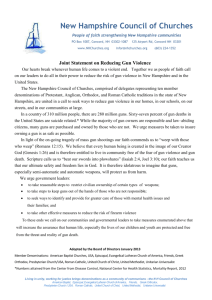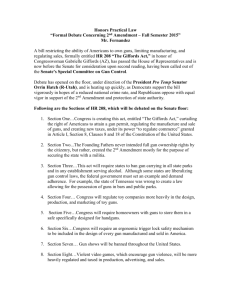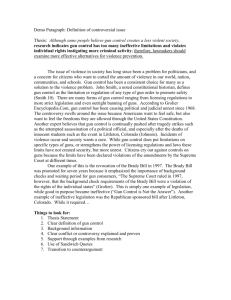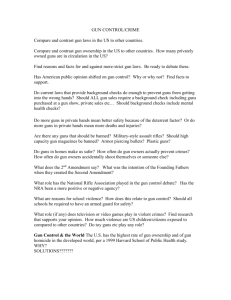an article for their publication
advertisement
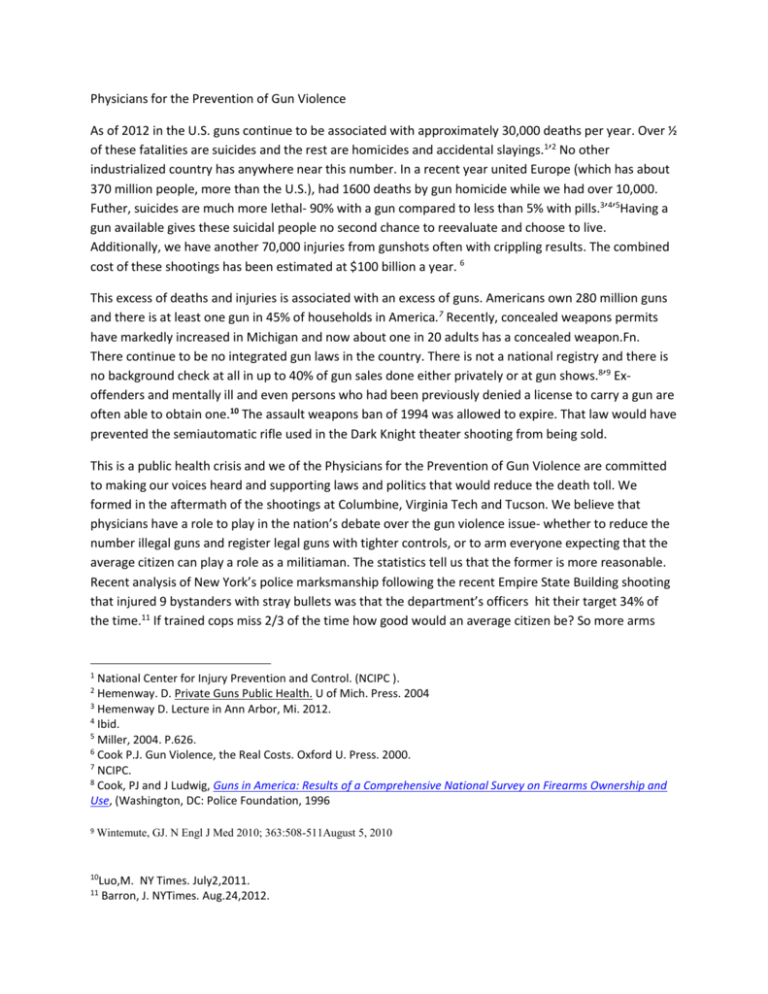
Physicians for the Prevention of Gun Violence As of 2012 in the U.S. guns continue to be associated with approximately 30,000 deaths per year. Over ½ of these fatalities are suicides and the rest are homicides and accidental slayings.1’2 No other industrialized country has anywhere near this number. In a recent year united Europe (which has about 370 million people, more than the U.S.), had 1600 deaths by gun homicide while we had over 10,000. Futher, suicides are much more lethal- 90% with a gun compared to less than 5% with pills.3’4’5Having a gun available gives these suicidal people no second chance to reevaluate and choose to live. Additionally, we have another 70,000 injuries from gunshots often with crippling results. The combined cost of these shootings has been estimated at $100 billion a year. 6 This excess of deaths and injuries is associated with an excess of guns. Americans own 280 million guns and there is at least one gun in 45% of households in America.7 Recently, concealed weapons permits have markedly increased in Michigan and now about one in 20 adults has a concealed weapon.Fn. There continue to be no integrated gun laws in the country. There is not a national registry and there is no background check at all in up to 40% of gun sales done either privately or at gun shows.8’9 Exoffenders and mentally ill and even persons who had been previously denied a license to carry a gun are often able to obtain one.10 The assault weapons ban of 1994 was allowed to expire. That law would have prevented the semiautomatic rifle used in the Dark Knight theater shooting from being sold. This is a public health crisis and we of the Physicians for the Prevention of Gun Violence are committed to making our voices heard and supporting laws and politics that would reduce the death toll. We formed in the aftermath of the shootings at Columbine, Virginia Tech and Tucson. We believe that physicians have a role to play in the nation’s debate over the gun violence issue- whether to reduce the number illegal guns and register legal guns with tighter controls, or to arm everyone expecting that the average citizen can play a role as a militiaman. The statistics tell us that the former is more reasonable. Recent analysis of New York’s police marksmanship following the recent Empire State Building shooting that injured 9 bystanders with stray bullets was that the department’s officers hit their target 34% of the time.11 If trained cops miss 2/3 of the time how good would an average citizen be? So more arms 1 National Center for Injury Prevention and Control. (NCIPC ). Hemenway. D. Private Guns Public Health. U of Mich. Press. 2004 3 Hemenway D. Lecture in Ann Arbor, Mi. 2012. 4 Ibid. 5 Miller, 2004. P.626. 6 Cook P.J. Gun Violence, the Real Costs. Oxford U. Press. 2000. 7 NCIPC. 8 Cook, PJ and J Ludwig, Guns in America: Results of a Comprehensive National Survey on Firearms Ownership and Use, (Washington, DC: Police Foundation, 1996 2 9 Wintemute, GJ. N Engl J Med 2010; 363:508-511August 5, 2010 10 Luo,M. NY Times. July2,2011. Barron, J. NYTimes. Aug.24,2012. 11 actually make the populace less safe. Similarly, if you have a gun in your house you are 3-4 times more likely to be the victim of an injury than if you don’t. 12’13 Guns don’t have to be outlawed in order to reduce gun violence. Today cigarettes can be purchased at most convenience stores and supermarkets, but the incidence of bronchogenic carcinoma in men continues to decline-because men are smoking less than they did 50 years ago. Why? Because, due to an intensive educational effort spearheaded by physicians and the Office if the Surgeon General, the public has been alerted to the hazards of smoking, and, most importantly, public attitudes about cigarette smoking have undergone a sea change-smoking has become socially unacceptable in many circles and is now prohibited in many public spaces. In 2008 the Supreme Court ruled that the Constitution’s Second Amendment protects an individual’s right to carry a gun, but made a point of not proscribing regulation of their sale or licensing or prohibition of their presence in public places. Much can be done to reduce gun-related violence through both governmental and non-governmental actions short of outlawing guns. Physicians can and should be involved. Among their concerns physicians in Michigan should consider lobbying against Senate Bill 58 which would allow concealed guns to be carried into schools, churches , libraries and other public places and press the legislature to repeal Michigan’s “Stand Your Ground” law. Also they should get behind congressional efforts to legislate elimination of the “gun show loophole,” (sale of guns to individuals without background checks.) Physicians for the Prevention of Gun Violence (PPGV) has grown to almost 100 members in the last year and includes the heads of several departments. We also have a few medical students, physician assistants and nurse practitioners. We initially appealed to local mayors to join Mayors Against Illegal Guns (MAIG), a national group of over 600 mayors headed by Michael Bloomberg of New York. Ann Arbor Mayor John Hieftje, Ypsilanti’s Paul Schreiber and Saline’s Gretchen Driskell have joined. And PPGV has been in contact with MAIG and with the Brady Campaign, the two national groups most active in this issue. Then we contacted local law enforcement and have begun to work with the sheriff. PPGV also helped with the documentary panel for the Ann Arbor screening of the movie ‘Living for 32’ about the Virginia Tech shooting deaths of 32 students. This year PPGV is bringing David Hemenway, the nation’s gun injury expert from Harvard University, to Ann Arbor to address physicians at St. Joe , the U.M., and the public. And we are planning working on legislation when feasible and on visiting other communities to encourage new physician groups to form. Finally, we are open to new members and new ideas. Please join us by sending your email address to that of one of ours listed below. Jerry Walden jswalden@umich.edu (Call 734 9732345 with questions.) 12 Kellerman, New England Jn. Medicine, 1993. Branas et al, “Investigating the Link Between Gun Possession and Gun Assault,” American Journal of Public Health, 99(11)(2009), published online ahead of print, Sep 17, 2009 13 Andrew Zweifler zweifler@med.umich.edu


